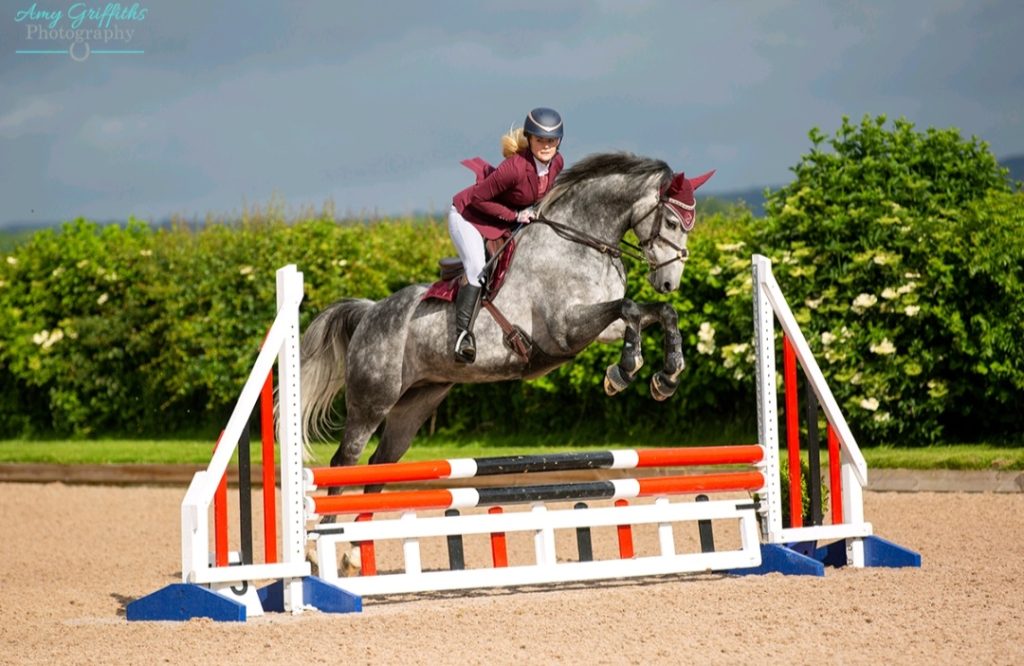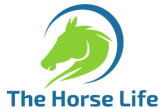
My journey from showing to showjumping – by Samantha Osborne
After many years of 1am starts and driving hours to shows to be very out of pocket, I decided to make the transition from showing to showjumping. Doing British Showjumping was a childhood dream and I have loved every minute of my showjumping journey so far. Showing was very good to me and I was lucky enough to qualify and compete a range of horses at RIHS and HOYS but nothing gives me the buzz like jumping a course of showjumps!
After a few private lessons on a friend’s experienced showjumper, I started to do some voluntary work at her yard. I had so much fun riding different types and getting the chance to practise showjumping that I ended up riding up to 6 horses a day several times a week. I learned how to use a neck strap for the first time and also how to adapt my position to suit a jumping saddle instead of a straight cut showing saddle. I spent a lot of time grooming and assisting at arena hire so that I could watch and learn. I also attended some British Showjumping shows at local venues to watch other combinations. Committed to learning and progressing, I also invested in some books about showjumping and attended demonstrations, such as the Geoff Billington demonstration at Stainsby Grange EC. Whenever Horse and Country Channel or BBC Red Button share footage from international shows, I am glued to the TV! I spend hours trying to absorb information and I try to observe how different riders get results.
Dorris
An old showing friend was very generous in offering me some BS rides on a ticket on her experienced eventing mare: Dorris. I felt so excited to become a British Showjumping member for the first time! The online membership area is brilliant as it allows you to plan way ahead with show dates. You can also access every horse’s results record. My favourite part of the BS membership area has to be the downloadable certificates that get added to your area at the end of each qualifying period. Although I was only jumping 85cm Amateur First Round classes, I was absolutely buzzing at each show! An 85cm BS track feels much bigger than your average unaffiliated course due to the oxers being up to height and width. Club classes may be less intimidating to riders new to jumping as they are much smaller heights and don’t contain doubles. It is also important to note that the jump off section is always up to 10 cm higher than the first round; for example, a 1m Discovery class will have a 1m10 jump off. If you get into the ring and things are not going to plan, you can simply raise your hand, pull up and retire.
I purchased a competition jacket, some competition shirts, some white breeches and a BS legal whip. I was also very fortunate to win a social media giveaway for some made to measure boots, which completed my showjumping wardrobe. I jumped in a navy jacket for my first season but when I knew I was hooked on jumping for life, I treated myself to a burgundy Animo competition jacket, which I absolutely love! As well as kitting myself out, I have also started to build up a collection of jumping cut saddle pads, suitable leg protection for horses and jumping bridles. The first time I jumped a double clear in an 85cm, I learned the hard way about boot rules. I jumped a mare in a set of sport boots not realising that only fetlock boots were permitted for amateur classes. I would advise others to read the rule book and don’t be afraid to ask questions to staff and other riders at events. People are so friendly at shows and I have made lots of new friends in such a short period of time.
Following my short experience on Dorris, I was then trusted to ride a much more challenging KWPN gelding. I was quite intimidated by his 18.3hh height but I was keen to challenge myself to learn to ride a different type of horse. I was very grateful for the opportunity and worked hard on the yard to express my gratitude for the experience. Not only did I do my first stay away show, I also jumped my first Discovery class, which felt enormous at the time! Despite being quite out of my depth and winging it at times, I was still hungry for more…
Jubilee
I began teaching and schooling part time on a different private yard. One of the mares at the yard was known to me from the show ring. She didn’t have a job or a rider for anything more than hacking out. We clicked quickly and so I invested time into getting her fit and developing her jumping experience as she was very green and raced at fences. I achieved this by doing lots of grid work, including rows of bounces, as well as a range of pole exercises. I spent a lot of time doing flat work to improve control as she was strong. We did circuit training in the fields and at the local gallops. We attended an unaffiliated show and won. Her owners were happy for me to register her with British Showjumping and for the next 53 rounds she jumped, she didn’t stop once and she was speedy enough to bag a few red rosettes and some prize money (which is about £30 per class for a win). We mainly competed at British Novice and I was delighted when she jumped her fourth double clear to qualify for the second rounds. She also finished in the top 3 of the points table for Star of the North. Jubilee was a complete pleasure to work with and I had such great fun with her at stay away shows, including Western Lawns and Spooktacular. With expert tuition from Paul Barker, Geoff Billington and Peter Allen, the 15hh pure Irish Draught stepped up to Discovery classes just 5 months into learning to jump. Having a supportive, enthusiastic and positive trainer is vital. British Showjumping provides a list of accredited trainers on their website. Whenever possible, I asked someone to video my rounds so that I could watch them back and reflect on what went well but also what I needed to change for next time. As well as collecting cool Instagram content, videoing classes are a great educational tool.
Kornetto
A lady who I met in the showing world tracked my results and asked if I would ride for her. She purchased a stunning, impressively bred KWPN gelding. Kornetto had no previous British Showjumping experience and was quite green in all ways. I attended clinics with Sarah Tubbs to socialise him with other horses, and I hired venues to introduce him to courses of jumps with fillers. He was spooky but my instructors told me to ride him forward around the jumps so that he didn’t have time to think about being silly. I registered him with British Dressage and worked on his flat work a lot at home as I believe that established flatwork is necessary when jumping courses. Kornetto mastered flying changes and his canter became more adjustable and rhythmical. We registered him with BS and began by attending shows to jump clear rounds. British Showjumping allows you to attend training shows or jump clear rounds and classes on a ticket so that it is not added to a horse’s record. If the horse shows potential and you wish to pursue a jumping career, you can then register the horse. I deliberately trained at venues that had courses built by BS qualified course builders, such as Richmond Equestrian Centre.
Bertie
I was also fortunate enough to secure a long term loan arrangement of an Irish Sport Horse gelding who I found advertised for sale on Horse Quest. He had suffered some limb injuries and although he has a BS record, he had quite a lot of stops and eliminations recorded and was still in British Novice on points (less than 125 points). I can’t afford to buy horses and so I jumped at the chance to loan Bertie, who I knew would give me the opportunity to step up in track again. He is much less forward going than other horses I have ridden but as a result of this I have really had to learn to use my leg. We have competed regularly so that I can gain experience and he can build his fitness. In the first 5 months, we qualified for seconds rounds in the 85cm, 95cm, British Novice and we jumped up to 1m10 double clear. We picked up 4 wins, I rode my first showjumping double, we won at a stay away show (Harrogate Amateur Festival) and we are currently sitting in the top 20 of over 800 horses in the Northern Bronze League. Although he is not straight forward and push button, he is a really genuine boy and I would encourage anyone who is wanting to learn the ropes to start off on a less sharp, more forgiving school master rather than a hot bred showjumping rocket. Building your confidence slowly is important as it is easy to knock both your confidence and your horse’s confidence as the jumps get higher, the courses become more technical and the striding takes some planning. Most of my practices on Bertie has been in the ring as I don’t want to over jump him at home. To keep him fresh and to not add additional wear and tear to his back and limbs, I make sure I give him a really good warm up and cool down, a variety of exercise and the best possible range of supplements and feed from Synovium Supplements and Blue Chip Feed. Furthermore, he has physiotherapy every 8 weeks and regular saddle fit checks to make sure he is able to compete to the best of his ability.
I feel much more confident in my ability as a rider to secure double clears at British Novice height now. I would like to continue pushing myself to jump at new venues, qualify for new championships, jump bigger tracks and ride new horses. I am very fortunate that I have the rides on 3 showjumping bred youngsters in a few year’s time. In the meantime, I am hoping to source another horse to jump confidently at Newcomers and hopefully try some Foxhunter classes too.
Any Questions?
If ever you see me at a show, please come and say hello! Should you have any further questions about making a discipline shift to BS, direct message me on Instagram @samanthaosbornequestrian and I would be happy to help guide you in the right direction.
5 top tips I have learned along the way:
- Don’t put your stirrups up several holes. You need to be able to ride in a light seat and allow the horse room to bascule over a fence but you need to ride long enough so that your leg is on the horse. As they say in the racing world: “Ride long, live long!”
- Although it is tempting to ride faster and turn tighter in a jump off, make sure you collect your qualifications for double clears first. It is easy to jump out of a class quickly; for example, once you have collected 225 points, you have to compete in the 90 Open against experienced horses rather than against British Novice horses. You get 5 points for every double clear plus additional points for where you are placed.
- Be considerate and patient in a warm up arena. It is polite to inform other riders if you are approaching a fence, and of course you should only jump fences in the direction indicated (red flag on the right wing). Try to jump a cross pole, a few uprights and then connect to an oxer before going into the ring. If you only jump single fences at a time, you are not encouraging your horse to travel forward on landing.
- Allow yourself plenty of time to walk the course and walk distances between doubles. Each horse has a different length of stride and you need to ride the course and distances to suit the individual horse’s needs. Generally, I allow two of my natural strides for a landing, 4 for a horse’s stride, and then 2 strides for take off. Sometimes the distances are perfectly suited but other times you need to push for a longer stride or collect and chip in a bit closer! Most venues tend to time the second half of the course. Make sure you plan your jump off course lines according to your horse’s strengths; for example, Bertie will not attempt to jump for me unless I give him a minimum of 3 strides into a fence and therefore I can’t turn tight at a jump but he is also very slow and so I have to make up time by taking the shortest possible route and maintaining rhythm.
- Stay away shows are brilliant for confidence building. As the days go on, you feel more able to step up in track. Venues allow you to change classes the evening before each jumping day. This really helps horses to progress. The evening parties are always fantastic too! Overall, at an average of £17 a class, you get great value for money.
Instagram – @samanthaosborneequestrian
Website – Samantha Osborne Equestrian





